Sourdough Donuts with Cinnamon Sugar
These are true homemade Sourdough Donuts, made without any commercial yeast. A slow fermentation gives these donuts a spectacular flavor and texture. They’re like no donuts you’ve ever tasted.
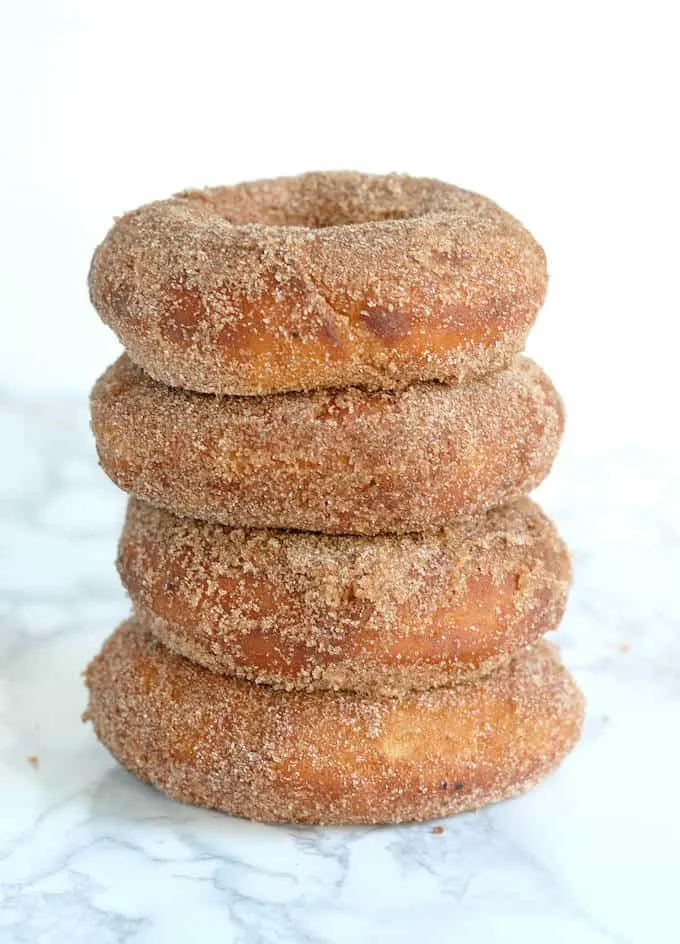
Table of contents
What makes Sourdough Donuts taste so good?
Making donuts with the natural yeast of a sourdough starter takes them into another stratosphere.
Seriously, these donuts are GOOD. The starter gives the donuts a special chewy texture airy crumb, and deep flavor.
If you don’t have one, check out my post to learn How to Make a Sourdough Starter. Then check out my system to Feed and Maintain Sourdough Starter.
The recipe is a 2 day process. Don’t worry though, the vast majority of time is hands-off.
I can’t wait to make these treats again. They’re totally worth the time and effort–and calories. Now, if you’ll excuse me, I need to jump on the elliptical…
Ingredients
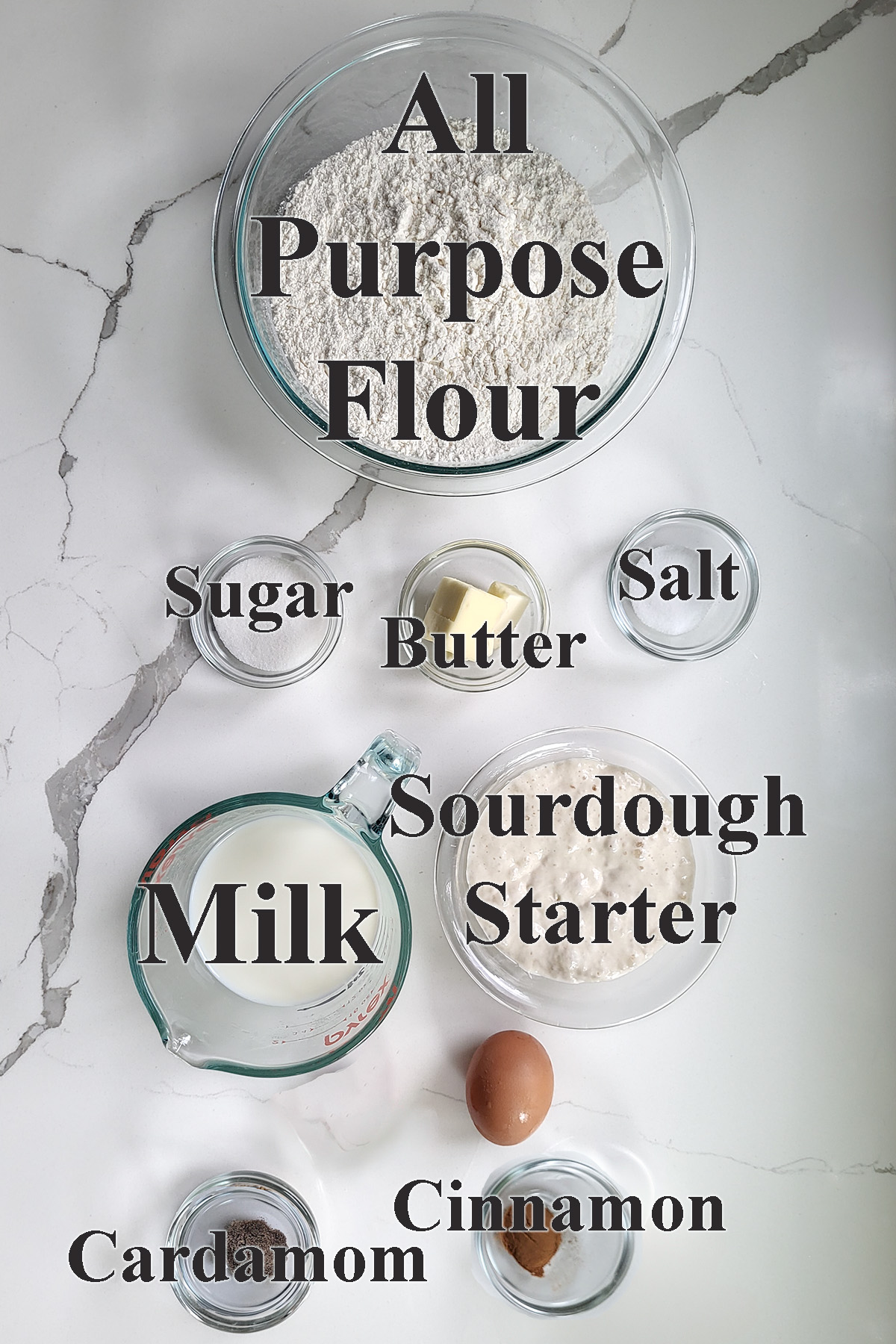
Ingredient Notes
- Sourdough Starter – Your starter should be well-fed and at peak activity when you make the dough. The recipe was developed using a 100% hydration starter.
- All Purpose Flour – Medium protein ap flour makes a dough that is strong enough to rise high in the fryer, but soft enough to make a tender donut.
- Sugar – Just a hint of sugar tenderizes and sweetens the dough.
- Milk – Scalding then cooling the milk alters the protein in the milk which can interfere with gluten development. Don’t skip the scalding step.
- Spices– A hint of cardamom is lovely along with the cinnamon. You can skip the cardamon if you prefer.
Process Photos
Here’s what the recipe process looks like at each stage. Refer to the recipe card below for measurements and exact instructions.
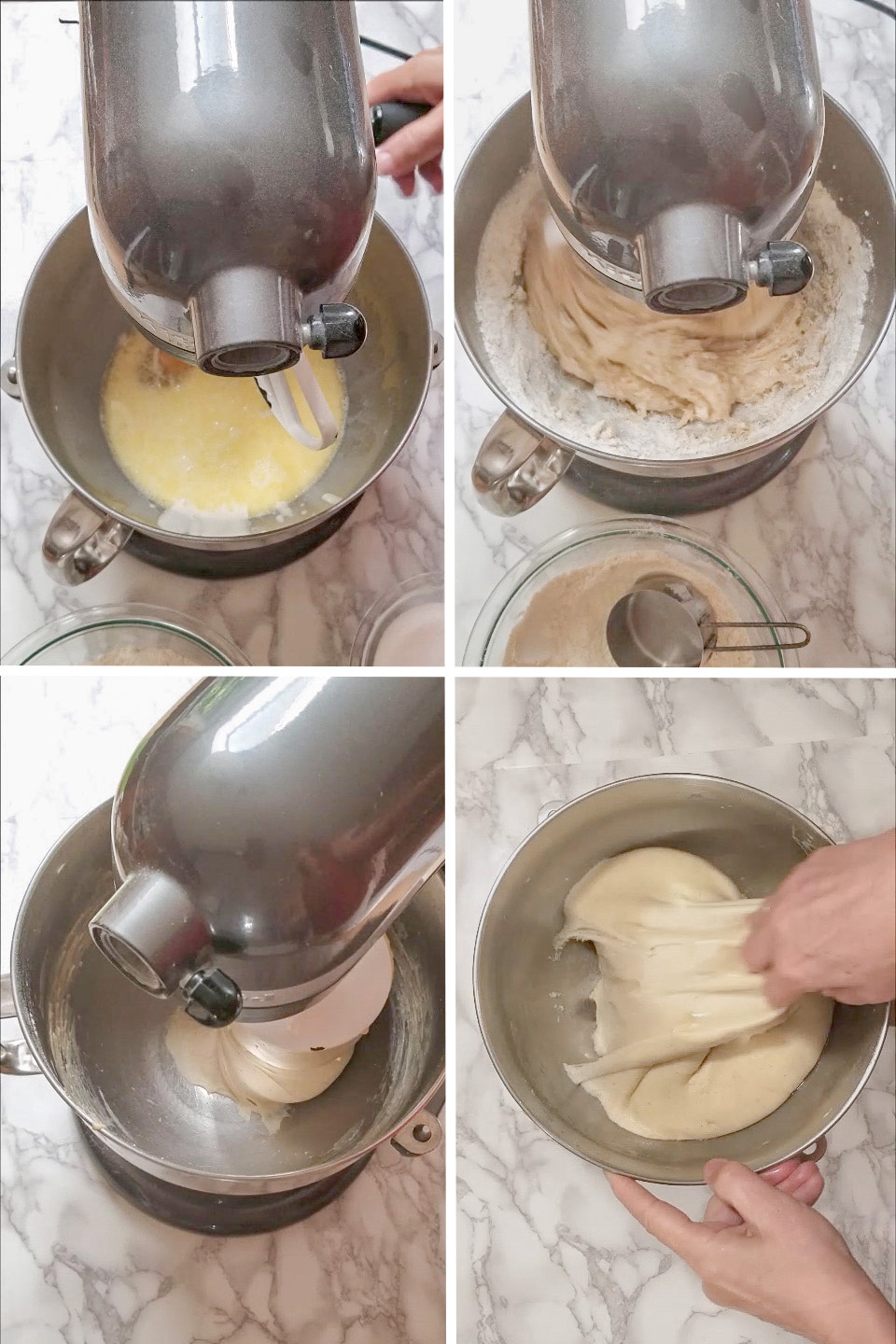
- Combine the milk, butter, egg and active sourdough starter in a mixing bowl or the bowl of a stand mixer. Mix using the paddle attachment.
- Add the sugar spices and some of the flour. Switch to the dough hook.
- Add the remaining flour and knead until the dough clings to the hook and clears the sides of the bowl.
- Set the dough aside at room temperature for 3-5 hours for fermentation. Every hour fold the dough. Refrigerate the dough overnight.
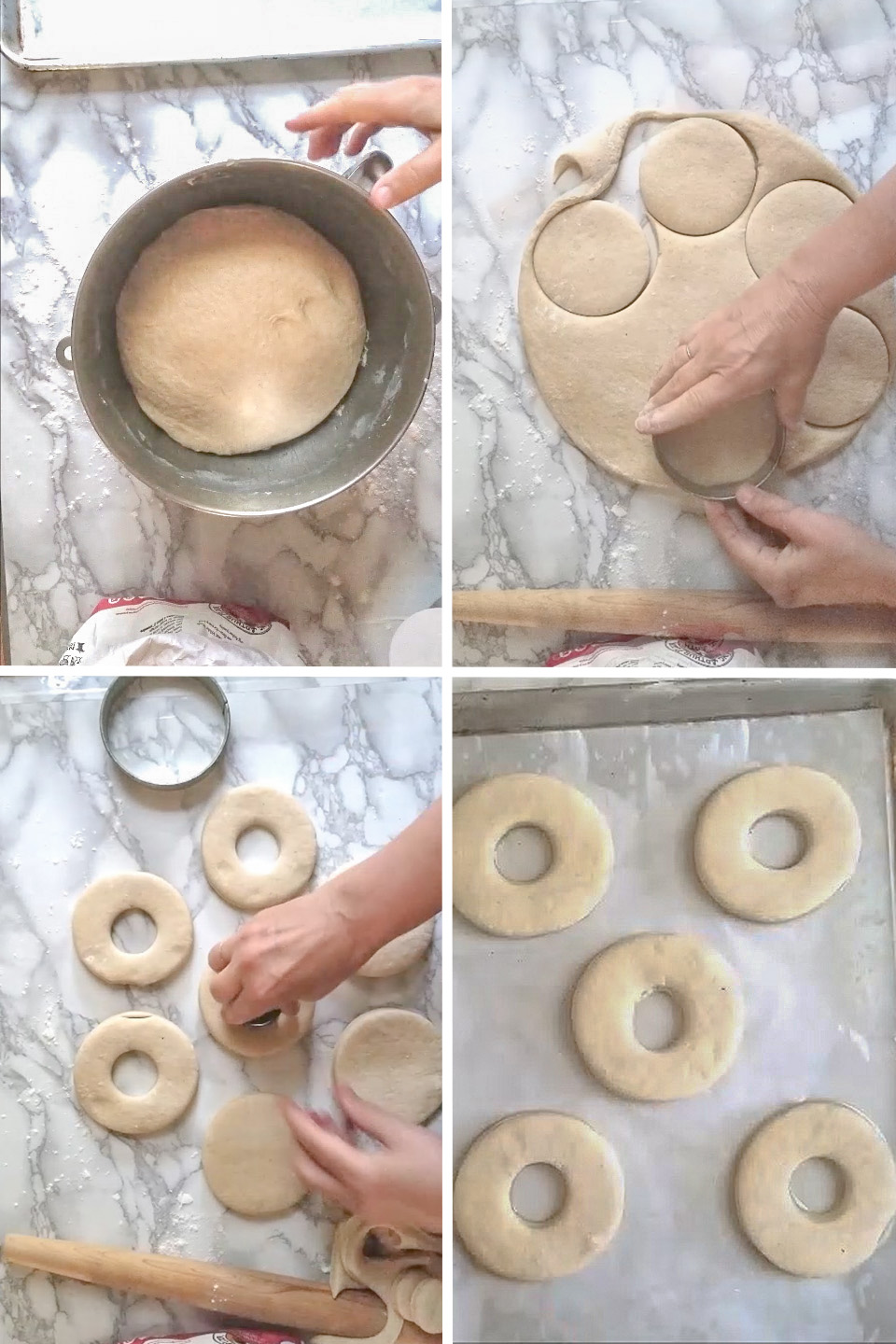
- In the morning, take the dough out of the fridge. Turn the cold dough out onto a lightly floured surface and roll to 1/2″ thick.
- Use a 3-4″ round biscuit cutter or cookie cutter to cut donuts. You can also use a donut cutter which has a center ring for cutting the holes. Reroll the scraps and continue cutting until all the dough is used.
- Use a smaller cutter to cut the donuts holes. You can re-roll the donut holes with the scraps or save them and fry them.
- Set the donuts into a baking tray lined with lightly oiled parchment paper. Cover and set aside until the donuts rise to almost double.
Did you know?
Sugar and cinnamon can slow down fermentation. Be patient with the dough and keep it in a warm spot to keep the dough active.

- While the dough is rising heat the oil until it registers 350F on a candy or probe thermometer. The dough is ready when the dimple slowly fills in when you press it. If it bounces right back it’s not ready.
- Fry the donuts a few at a time, flipping half way through to brown both sides.
- Lift the donut out of the oil and allow the excess oil to drip back into the pan.
- Immediately toss the hot donut in the spiced sugar.
Baking Schedule
- Feed your starter early in the morning of the day you will make the dough.
- Mix the dough in the afternoon. Allow it to ferment at room temperature until evening. The time will vary based on the temperature of the dough and the ambient temperature.
- Refrigerate the dough in the evening before going to bed.
- Take the dough out first thing in the morning and cut the donuts. Leave them at room temperature to rise for 1 1/2- 2 hours.
- Fry the donuts and serve while they’re still warm.
Variations
Glazed Doughnuts
Skip the cinnamon sugar and make a glaze. Combine 2 cups of powdered sugar with about 1/4 cup of milk. The glaze should be the texture of heavy cream. Allow the donuts to cool on a wire rack for about 5 minutes. While they’re still fairly warm dunk them in the glaze.
Baked Donuts
While the doughnuts are rising, preheat the oven to 400F. Bake until the donuts are light and golden brown, about 10-15 minutes. Toss them with spiced sugar or dunk in glaze while they’re still warm.
Filled Donuts
Do not cut a hole in the center of the dough rounds. Fry the donuts then allow them to cool. Fill a pastry bag fitted with a small, plain tip with jelly or custard. Poke the pastry tip into one end of the donut and pipe in the filling.
Storage
The donuts are best still warm from the fryer. They will keep at room temperature for 1 day. Leftovers can be frozen. To revive previously frozen donuts, warm them in a low oven.
I know you hate to throw away that sourdough discard. Check out these recipes that use sourdough discard.
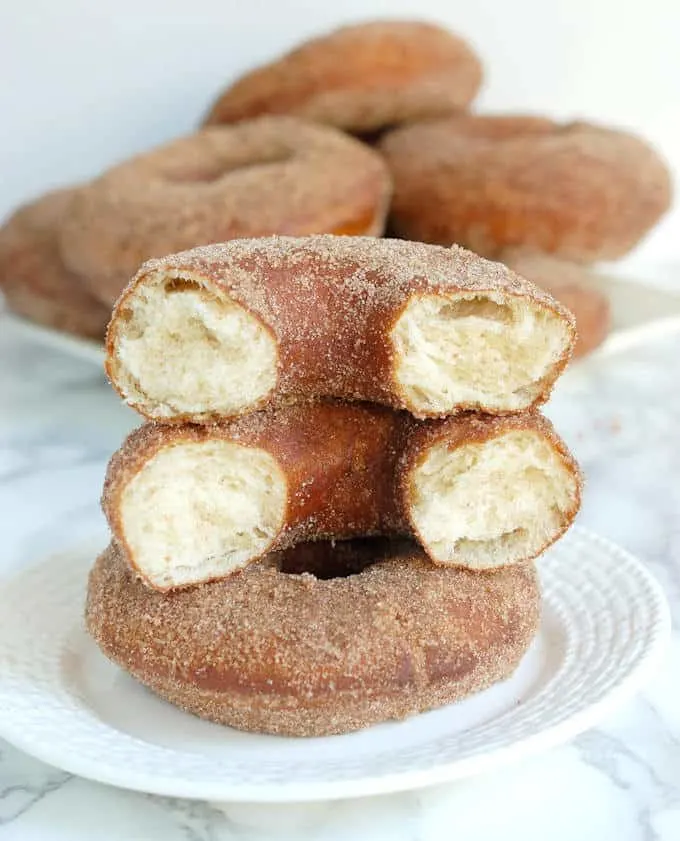
If you love this recipe as much as I do, I’d really appreciate a star rating and a quick comment. Ratings and comments help my recipes show in search results. Thanks!
Sourdough Donut Recipe
Video
Ingredients
- 8 oz whole milk (1 cup, warmed to about 110°F)
- 1 large egg (room temp)
- 2 oz unsalted butter (melted)
- 8 oz active sourdough starter (1 cup)
- 17 ½ oz unbleached all-purpose flour (3 ½ cups, see note)
- 4 oz granulated sugar (½ cup)
- 1 teaspoon cardamom
- 1 teaspoon cinnamon
- 1 teaspoon table salt
- Cinnamon Sugar for coating
Instructions
Make the dough (day 1)
- Combine 8 oz whole milk, 1 large egg and 2 oz unsalted butter with 8 oz active sourdough starter in a mixer bowl. With the mixer running, add 4 oz granulated sugar, 1 teaspoon cardamom, 1 teaspoon cinnamon, 1 teaspoon table salt and 2.5 cups of the flour. Mix until it forms a thick batter.
- Switch to the dough hook and add the remaining flour. The dough will start out quite sticky. Knead on medium low speed for 15 minutes (speed 2 on my stand mixer) until the dough clings to the hook and clears the sides of the bowl.
- Scrape the dough into a lightly floured surface and knead into a smooth ball. Place the dough into a lightly oiled bowl, turning once to coat the dough. Cover and set the dough aside at room temperature for fermentation.
- After 1 hour uncover the bowl, lift one edge of the dough over into the middle of the dough. Repeat with the other three sides of the dough then flip the dough over. Cover the bowl and set aside.
- Every hour for another 2-3 hours repeat the folding as described above. After 3-4 hours of fermentation the dough should be lively, elastic and airy. If the dough is still sluggish give it another hour or two at room temperature. Cover and refrigerate overnight.
Make the Donuts (day 2)
- Remove the dough from the refrigerator. While the dough is still cold, without kneading, roll to 1/2" thick on a lightly floured surface.
- Use a 4" round cutter to cut donuts. Use a 1.5" cutter to cut center hole. Line the donuts on a lightly-oiled, parchment or silpat lined baking sheet, leaving space between the donuts for the dough to rise (I used 2 baking sheets). Reroll the scraps of dough and continue cutting donuts until all the dough is used up. Brush the tops of the donuts lightly with oil.
- Cover the sheet pans with plastic wrap and set aside to rise. The donuts are ready when you poke the dough and the dent slowly fills in. If the dough bounces right back it’s not quite ready. This rise should take about 1 1/2 hours. The time will vary based on the temperature of the room.
- Meanwhile, heat 2 quarts of oil to °350 °F in a large heavy pot. Fry the donuts a couple at a time, about 2-3 minutes per side, until golden brown and puffy.
- As you take each donut out of the oil, immediately roll in the cinnamon sugar to coat the entire donut. Set on a cooling rack while you fry the rest of the donuts.
- Best eaten warm or within a couple of hours of frying.
Would you like to save this recipe?
As an Amazon Associate and member of other affiliate programs, I earn from qualifying purchases.




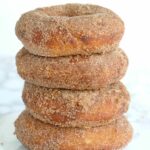
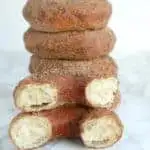





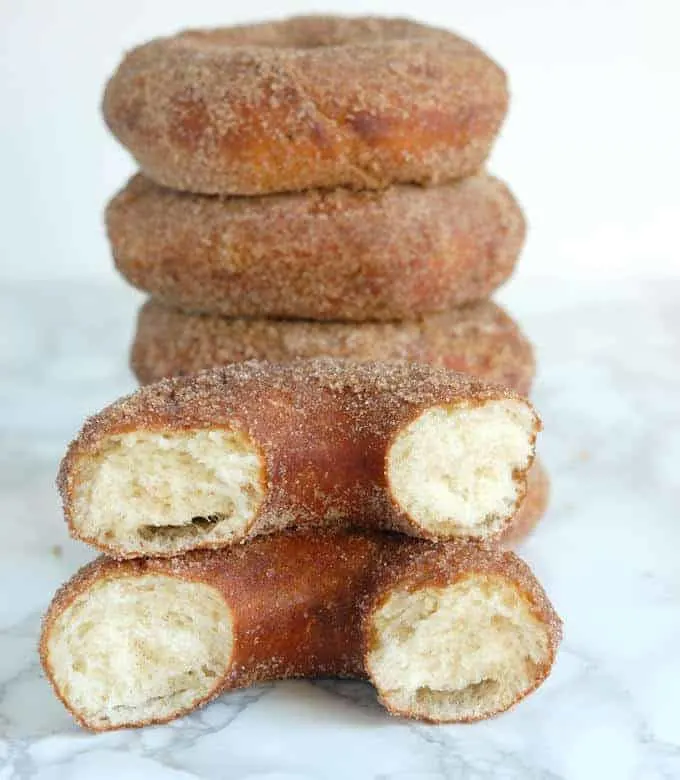
With the milk in this recipe I’m concerned about bacterial growth during the short rise times at the start— how do I mitigate the risk of contamination during room temperature rise time? Should I pasteurize my milk first (heat to 180F) and cook with that? TIA
Well, I assume you are using pasteurized milk in the first place? If not, I can’t recommend using raw milk in this recipe. Otherwise, if you are using regular pasteurized milk it will be fine. I’ve made many, many, many sourdough breads and pastries that have milk in the dough and it’s never been a problem.
I’ve used this recipe many times and is loved by my whole family.
This are easy and just awesome. After overnight in fridge I took out, to cut and rise and potentially cook 1st thing in the morning and after they sat for an hour, raisini…. I had to leave quickly so i ended freezing the dough for about 8 hours!!!
Came back home and let it thaw for about 4 hrs… they rose fine… they bounced back. I air fried at 425 for 5 mins each side. They were fluffy and yu.my and I’m making it again!!!
Made them custard filled with chocolate on top
Wonderful, good to know that freezing the cut donuts works. I can imagine making a batch and freezing half for later.
Did they work ok in air fryer? Did you spray with oil or anything first?
They worked great. Very fluffy and crispy. I have increased to 450… but they crispy to much. 425 is the ways to go. I have done them both ways, without anything and with butter right as they come out. I prefer without butter because of the custard filling and chocolate.
We have company this weekend. I NEED to make these for them.
What oil do you recommend for frying the donuts in?
I use vegetable oil.